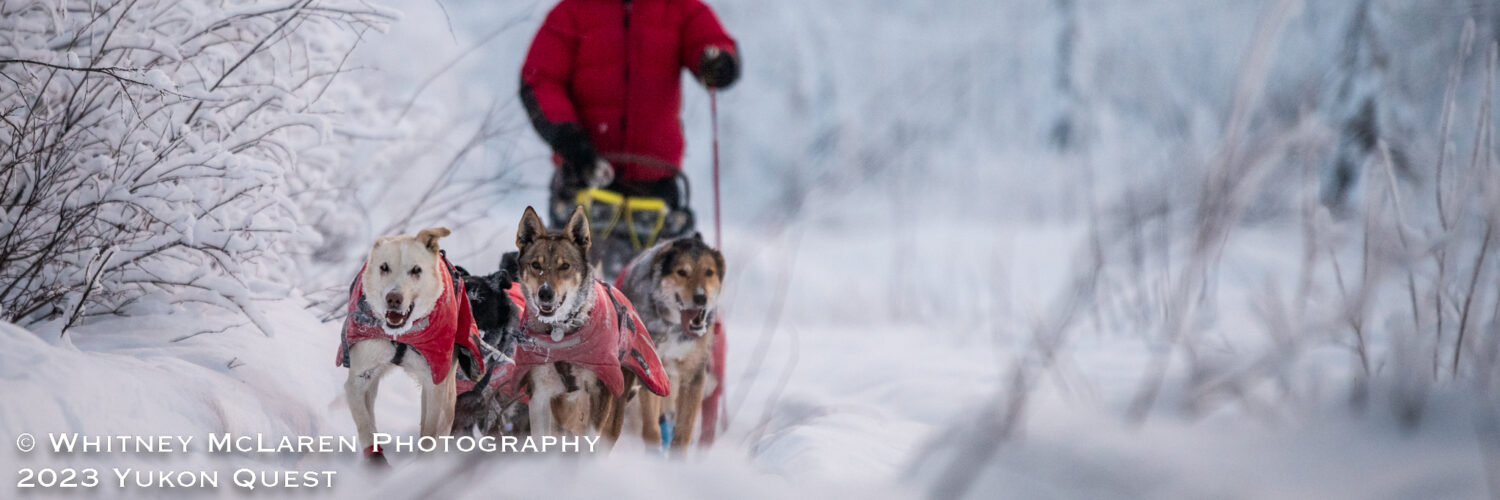The Yukon Quest began as a 1000 mile international race traveling from Fairbanks Alaska to Whitehorse Canada
Yukon Quest Race History
The Yukon Quest 1,000 Mile International Sled Dog Race gets its name from the “highway of the north,” which is the Yukon River and the historical winter land routes travelled by prospectors, adventurers and mail and supply carriers traveling between the gold fields of the Klondike and those in the Alaska interior.
Origins of the Yukon Quest
In 1983, four mushers sat at a table in the Bull’s Eye Saloon in Fairbanks, Alaska. The conversation turned to a discussion about a new sled dog race and “what-ifs”.
- What if the race followed a historical trail?
- What if it were an international sled dog race?
- What if the race went a little longer?
- What if it even went up the Yukon River?
As early as 1976, a Fairbanks to Whitehorse sled dog race had been talked of. But it wasn’t until this conversation between Roger Williams, Leroy Shank, Ron Rosser and William “Willy” Lipps that the Yukon Quest became more than an idea. The mushers named the race the “Yukon Quest” to commemorate the Yukon River, which was the historical highway of the north. The trail would trace the routes that the prospectors followed to reach the Klondike during the 1898 Gold Rush and from there to the Alaskan interior for subsequent gold rushes in the early years of the 1900s.
The first Yukon Quest 1,000 Mile International Sled Dog Race tested both race logistics and the talents of all involved. Twenty-six teams left Fairbanks in 1984. During the next 16 days, 20 teams arrived in Whitehorse. Six teams were forced to drop out along the way.
Sonny Lindner became the first Yukon Quest champion, completing the race in just over 12 days.
History of Sled Dogs in the North
As humans migrated across the Bering Straight and into North America, fully domesticated dogs accompanied them as far back as 15,000 years ago. It is well known that many northern Native cultures had dogs as prominent aspects of daily life, and there is archaeological evidence of dogs and harnesses in the same locations dating back prior to European contact with North America.
The use of canines as draft and pack animals in North America was a widespread practice in most Native cultures for thousands of years. In the far North, two main types of native dogs were the Eskimo or Inuit dog of coastal cultures, and the Interior Village dogs of Athabascan Indians and other First Nation groups. These two canine groups make up the indigenous genetic base for today’s modern Alaskan Husky.
According to some historic accounts, Russian traders followed the Yukon River inland in the mid-1800’s to acquire sled dogs from the interior regions of this waterway as the dogs of this area were reputed to be stronger and better able to haul large, heavy loads than the native Russian sled dogs.
The Gold Rush Era of the late 1800’s and early 1900’s saw tens of thousands of adventurers and gold seekers flow into the North. While the rivers provided excellent transportation corridors for half of the year, the extreme weather of the Northern Frontier demanded a more reliable and flexible means of transportation throughout the long winters. This became the era of the sled dog in the North. Everything that moved during the frozen season moved by dog team; prospectors, trappers, doctors, mail, commerce, trade, freighting of supplies…if it needed to move in winter, is was moved by sled dogs.
As airplanes took over the mail routes in the 1920’s and 1930’s, the sled dogs role in this area of society was diminished. With the coming of the highways and trucking transportation in the 1940’s and 1950’s, sled dogs lost their prominence in this area. The introduction of the snow machine (or snowmobile) in the 1950’s and 1960’s sounded the end of sled dogs dominating the traplines of the North, and began the decline of their general place within Northern society.
Recreational ‘mushing’ and the advent of sled dog racing became the primary focus of many mushers who wished to maintain their ties to these incredible animals and to a way of life that was disappearing from the Far North. As the need for larger, stronger dogs changed to the desire for greater endurance and running efficiency, lighter breeds of dogs were introduced to the genetic lineage of sled dogs.
Ironically, the Siberian Husky, a lighter, quicker breed from Russia, was a favored breed to introduce to the larger draft sled dog breeds of North America to increase their overall speed. This presents a direct contrast to the idea that Russian traders sought heavier draft-type sled dogs from the Interior regions of Alaska and the Yukon less than a century earlier to increase the hauling capacity of their lighter sled dogs!
‘Alaskan Huskies” are the most commonly used breed of sled dog in the North today. This cross-breed between any of the pure, northern canine breeds and other types of dogs is the result of many generations of genetically purposeful breeding that began in the late 1800’s and continues to this day.
These sled dogs can outrun almost anything on four legs over distances greater than 50 or 60 miles. They are well-known for their very tough feet, strong hearts and insulating undercoats are incredibly strong-minded while still being dedicated to the humans who love and care for them, and truly enjoy running in harness with their teammates and their mushers. Their sense of self confidence and individual accomplishment come from their ability to work in a manner similar to how their canine ancestors once worked…and the excitement in their eyes and voices when they are harnessed for a run or a race clearly illustrates this deep seated genetic drive to pull that defines modern Sled Dogs of the North.

